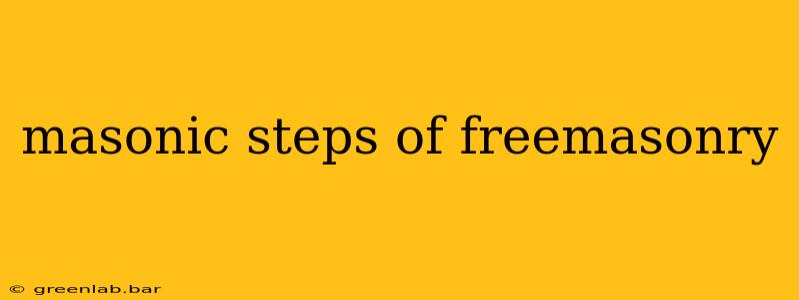Freemasonry, a fraternal organization shrouded in symbolism and ritual, uses a system of progressive degrees to guide its members on a path of self-improvement and moral development. Understanding the "steps" or degrees within Freemasonry is key to grasping its underlying philosophy. This exploration delves into the symbolic progression, focusing on the core tenets and lessons imparted at each stage. While specifics vary slightly between Grand Lodges (the governing bodies of Freemasonry), the overarching principles remain consistent.
The Three Craft Degrees: A Foundation in Symbolic Masonry
The cornerstone of Freemasonry lies in its three Craft degrees: Entered Apprentice, Fellowcraft, and Master Mason. These degrees form the foundation upon which further Masonic learning is built.
1. Entered Apprentice: The First Steps on the Path
The Entered Apprentice degree marks the initiation into Freemasonry. This stage is heavily symbolic, introducing the candidate to the fundamental concepts of morality, brotherhood, and self-improvement. Key lessons learned include:
- Obedience and Discipline: The Entered Apprentice learns the importance of following rules and instructions, developing self-discipline, and respecting authority within the structured environment of the lodge.
- Symbolic Representations: The tools and symbols presented, like the 24-inch gauge and the working tools, are introduced as metaphors for moral and ethical conduct. These aren't just tools; they're representations of character development.
- The Importance of Secrecy: The secrecy surrounding Masonic rituals is not about concealing wrongdoing, but about safeguarding the integrity of the symbolic lessons and the sacred space of the lodge.
2. Fellowcraft: Expanding Knowledge and Understanding
The Fellowcraft degree builds upon the foundation laid in the Entered Apprentice degree. This stage expands upon the symbolism and introduces new tools and lessons, including:
- The Development of Knowledge: Fellowcraft emphasizes the pursuit of knowledge and understanding, reflecting the importance of continued learning and self-education in Masonic principles. This includes studying the history and traditions of Freemasonry.
- Brotherly Love: The emphasis shifts towards fostering strong bonds of brotherhood, mutual support, and charitable work within the Masonic community and beyond.
- Symbolic Geometry: The Fellowcraft degree introduces more complex geometric symbolism, further emphasizing the importance of order, harmony, and proportion in life.
3. Master Mason: The Pinnacle of Craft Masonry
The Master Mason degree represents the culmination of the Craft, marking a significant milestone in the Masonic journey. This stage is characterized by:
- Moral and Spiritual Growth: The Master Mason degree focuses on the development of higher moral principles, spiritual growth, and the pursuit of wisdom. It highlights the importance of self-reflection and personal responsibility.
- Leadership and Service: Master Masons are expected to take on leadership roles within the lodge and demonstrate a commitment to service, contributing to the well-being of their community and fellow Masons.
- The Symbolic Temple: The degree uses the symbolic representation of King Solomon's Temple to illustrate the ideals of cooperation, perseverance, and the pursuit of higher goals.
Beyond the Craft Degrees: Advanced Degrees and Orders
Many Masons choose to continue their Masonic journey beyond the three Craft degrees, exploring various advanced degrees and orders, like the York Rite or the Scottish Rite. These degrees offer further layers of symbolic instruction and philosophical exploration. However, the Craft degrees remain the bedrock of Freemasonry, providing the essential groundwork for all subsequent Masonic learning.
Conclusion: A Lifelong Journey of Self-Improvement
The Masonic steps are not simply rituals; they are a carefully constructed path designed to foster personal growth, moral development, and a commitment to brotherhood and service. The journey through these degrees is a lifelong process of learning and self-discovery, a quest for self-improvement that continues long after the completion of the Craft degrees. The symbols, rituals, and lessons learned along the way serve as constant reminders of the Masonic ideals and the commitment to strive for a better self and a better world.

